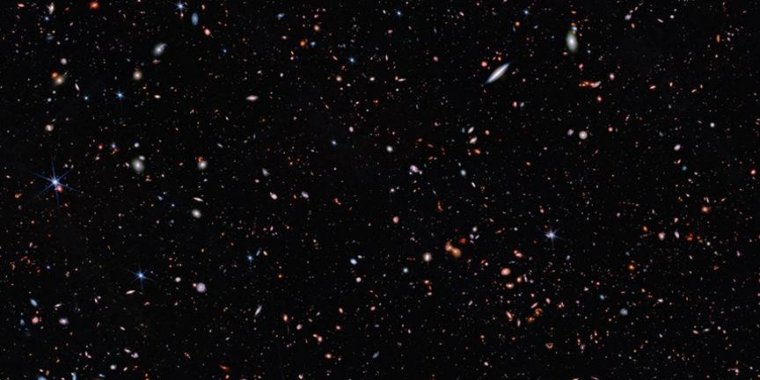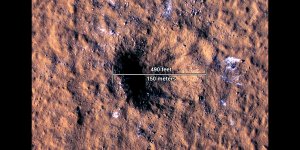| News / Space News |
Webb telescope reaches new milestone in its search for distant galaxies
An international team of astronomers, including scientists at the Universities of Cambridge, Hertfordshire and Oxford, has reported the discovery of the earliest galaxies ever confirmed in our Universe.

This image taken by the James Webb Space Telescope highlights the region of study by the JWST Advanced Deep Extragalactic Survey (JADES). Photo: NASA, ESA, CSA, M. Zamani (ESA/Webb)
Using data from the James Webb Space Telescope (JWST), scientists have confirmed observations of galaxies dating back to the earliest days of the Universe, less than 350 million years after the Big Bang – when the Universe was just 2% of its current age.
Images from JWST had previously suggested possible candidates for such early galaxies. Now, their age has been confirmed using long spectroscopic observations, which measure light to determine the speed and composition of objects in space.
These observations have revealed distinctive patterns in the tiny amount of light coming from these incredibly faint galaxies, allowing scientists to establish that the light they are emitting has taken 13.4 billion years to reach us, and corroborating their status as some of the earliest galaxies ever observed.
Scientists can also now confirm that two of these galaxies are further away than any observations made by the Hubble telescope – underlining JWST’s incredible power and ability to detect never-before-seen parts of the earliest Universe.
“It was crucial to prove that these galaxies do indeed inhabit the early Universe, as it’s very possible for closer galaxies to masquerade as very distant galaxies,” said Dr Emma Curtis-Lake from the University of Hertfordshire, lead author on one of two papers on the findings.
“Seeing the spectrum revealed as we hoped, confirming these galaxies as being at the true edge of our view, some further away than Hubble could see – it is a tremendously exciting achievement for the mission!”
The findings have been achieved by an international collaboration of more than 80 astronomers from ten countries via the JWST Advanced Deep Extragalactic Survey (JADES) programme.
The team were allocated just over a month of observation on the telescope, using the two on-board instruments: the Near-Infrared Spectrograph (NIRSpec) and the Near-Infrared Camera (NIRCam).
These instruments were developed with the primary purpose of investigating the earliest and faintest galaxies.
“It is hard to understand galaxies without understanding the initial periods of their development,” said Dr Sandro Tacchella from Cambridge’s Cavendish Laboratory and Kavli Institute for Cosmology, co-lead author on the second paper.
“Much as with humans, so much of what happens later depends on the impact of these early generations of stars. So many questions about galaxies have been waiting for the transformative opportunity of Webb, and we’re thrilled to be able to play a part in revealing this story.”
“For the first time, we have discovered galaxies only 350 million years after the big bang, and we can be absolutely confident of their fantastic distances,” said Brant Robertson from the University of California Santa Cruz, co-lead author on the second paper. “To find these early galaxies in such stunningly beautiful images is a special experience.”
Across 10 days of their observation time, the JADES team of astronomers focused on a small patch of sky in and around Hubble Space Telescope’s Ultra Deep Field, which for over 20 years has been a favourite of astronomers and has been analysed at the limit of nearly every large telescope to have existed.
However, with JWST, the team were able to observe in nine different infrared wavelength ranges, providing an exquisitely sharp and sensitive picture of the field.
The image reveals nearly 100,000 galaxies, each billions of light years away, in a pinprick of the sky equivalent to looking at a mobile phone screen across a football field.
The very earliest galaxies were identifiable by their distinctive banded colours, visible in infrared light but invisible in other wavelengths. In one rare continuous 28-hour observation window, the Near-Infrared Spectrograph was used to spread out the light emitting from each galaxy into a rainbow spectrum.
This allowed astronomers to measure the amount of light received at each wavelength and study the unique light patterns created by the properties of the gas and stars within each galaxy.
Crucially, four of the galaxies were revealed to originate earlier in the Universe than any previous observations.
“Our observations suggest that the formation of the first stars and galaxies started very early in the history of the Universe,” said Professor Andrew Bunker from the University of Oxford.
“This is a major leap forward in our understanding of how the first galaxies formed,” said Professor Roberto Maiolino from Cambridge’s Cavendish Laboratory and Kavli Institute for Cosmology, co-author on one of the two papers.
“We have been able to dissect the light coming from these galaxies in the very early universe and, for the first time, characterise in detail their properties. It’s really fascinating and intriguing to discover how young these systems were and that stellar processes hadn’t yet managed to pollute these galaxies with chemical elements heavier than helium.” (University of Cambridge)
YOU MAY ALSO LIKE





